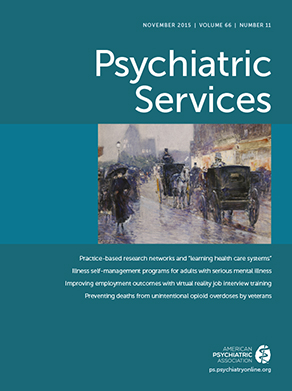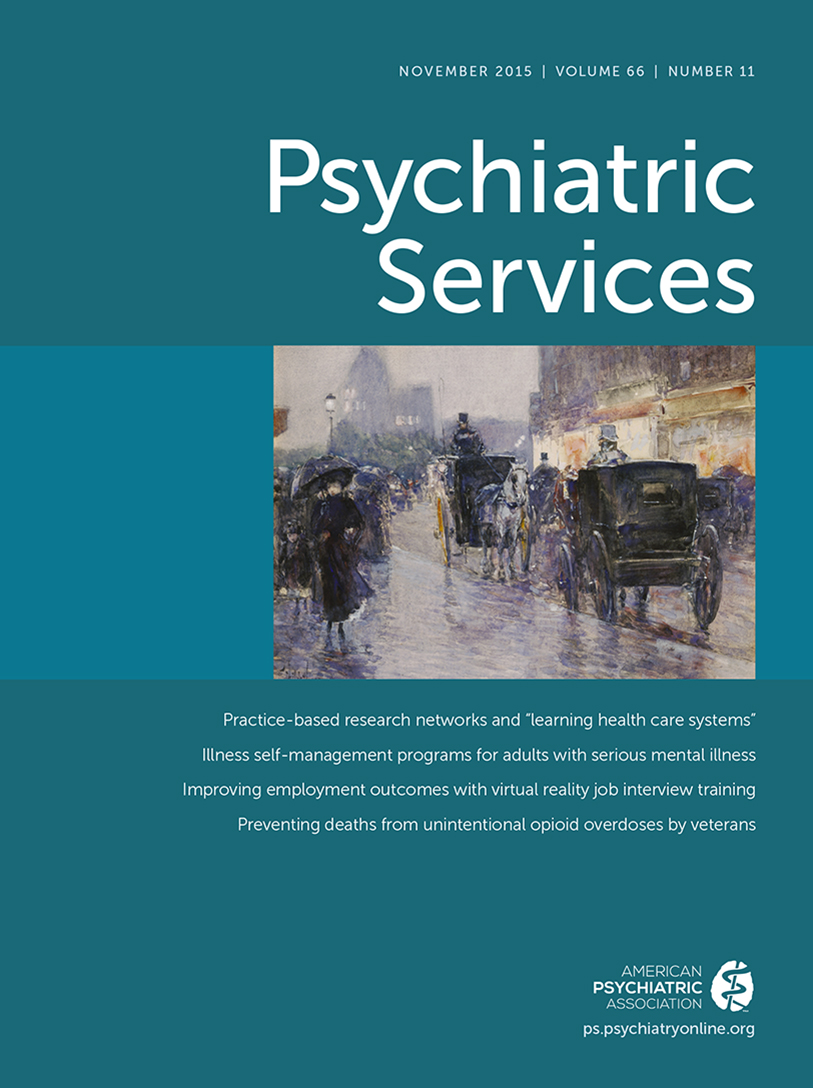People with schizophrenia report lower subjective quality of life than the general population (
1). Improvement in patients’ quality of life is an important aim for health services (
2), and identification of associated factors has the potential to inform clinical practice.
Previous studies have reported negative relationships between quality of life and psychiatric symptoms (
3) and positive associations with functioning (
4,
5). A recent study of patients served by assertive community treatment (ACT) teams found that patients achieving better functioning reported higher quality of life, regardless of improvement in symptoms (
6).
ACT is a community-based service delivery model for people with severe mental illness, a high level of comorbid health conditions, and poor functioning. The ACT approach provides more flexible and intensive support than common mental health services (
7,
8), and it has been shown to improve patients’ functioning (
9,
10). However, associations between practical and social functioning and satisfaction with various life domains in this population remain largely unknown.
Recently, the ACT model was introduced in Norway to improve services for people with severe mental illness who have not benefited from standard mental health services. The traditional health system consists of primary and specialized health care. The complexity of the service configuration may present impediments to accessing appropriate treatment for this population.
The aims of this study were to investigate the subjective quality of life in the Norwegian ACT population and to explore associations between subjective quality of life and patient characteristics, particularly practical and social functioning and satisfaction with various life domains.
Methods
The study was a cross-sectional survey of patients of 12 ACT teams in Norway. It was approved by the regional committee for health and research ethics.
Since 2009, the Norwegian Directorate of Health has provided funding for implementing ACT teams. A total of 12 teams were established between December 2009 and February 2011. A national evaluation of the teams was funded along with the implementation.
Patients enrolled in the teams’ first operative year were asked to participate in the national evaluation program. During the first year of operation, 337 patients enrolled with ACT teams, and 202 (60%) gave written informed consent to participate in the evaluation after the procedure had been explained. A total of 149 patients (44%) completed ratings of their subjective quality of life and were eligible for this study.
There were no differences between participants and nonparticipants in terms of gender, age, or diagnosis. However, participants had better functioning (Global Assessment of Functioning [GAF] score of 38.2 versus 35.6 out of 100, p=.008), were less commonly subject to involuntary outpatient treatment (N=41 versus 87, 28% versus 47%, p<.001), and were less likely to have problematic substance use (N=87 versus 124, 58% versus 71%, p=.020).
A majority of participants were male (N=101, 68%), of Norwegian origin (N=125, 86%), and unemployed (N=123, 83%). The mean±SD age was 38±10.5 years. More than half lived alone (N=91, 61%), but most had weekly contact with family or friends (N=125, 91%). A majority had a diagnosis of schizophrenia (N=110, 80%), almost 60% had problematic substance use (N=87), and they had major functional impairments (GAF score 38.2±9.1).
Demographic data were collected by the ACT teams. The Manchester Short Assessment of Quality of Life (MANSA) was used to assess subjective quality of life (
11). This self-report instrument is rated on a 7-point scale (1, “couldn’t be worse”; 7, “couldn’t be better”). The MANSA was developed from the Lancashire Quality of Life Profile (LQOLP), which was adapted from Lehman’s Quality of Life Interview (
5). The MANSA was chosen over the LQOLP because it is shorter and has been used in recent European ACT studies. The ACT staff measured patients’ functioning by using a revised version (
12) of the Practical and Social Functioning (PSF) scale, which consists of 32 items providing scores on eight subscales ranging from 0 to 8 (higher scores indicate better functioning). The PSF–Revised has good internal consistency (Cronbach’s alpha for subscales ranges between .735 and .903) and acceptable face validity (personal communication, Ruud T, 2014). The GAF measures overall functioning, and the Brief Psychiatric Rating Scale (BPRS, version 4) measures psychiatric symptoms. The BPRS comprises 24 items, giving four dimensions (
13). The Alcohol Use Disorder Identification Test (AUDIT) and the Drug Use Disorder Identification Test (DUDIT) are self-report instruments we used to screen for problematic substance use.
Demographic and clinical variables were presented with appropriate descriptive statistics. A linear regression model was fitted to assess the associations between mean MANSA score and patient characteristics. A multivariate model was built by Akaike’s information criterion. Associations between mean overall MANSA score and PSF subscales, and between MANSA and PSF subscale scores, were explored with bivariate and multivariate regression analyses. Any p values below 5% were considered statistically significant. Missing values were imputed for AUDIT (6% of cases), DUDIT (11% of cases), MANSA (.2% of cases), and PSF (.3% of cases). Analyses were performed with SPSS, version 22.
Results
The mean overall MANSA score was 4.26 (range 1.42–6.67). The participants were most satisfied with personal safety (4.65), relationship with the family (4.65), and accommodation (4.65). They were least satisfied with employment status (3.84), financial situation (3.79), and sex life (3.82).
The mean overall MANSA score was positively associated with age (coefficient=.03, 95% confidence interval [CI]=.01–.04, p=.001) and PSF (coefficient=.02, CI=.008–.035, p=.002) and negatively associated with anxiety and depressive symptoms (coefficient=–.53, CI=–.68 to –.39, p<.001). The mean overall MANSA score was not associated with gender, psychotic symptoms (BPRS positive/negative/agitation mania), substance misuse, or being subjected to involuntary outpatient treatment. Participants who had weekly contact with family and friends had higher mean MANSA scores than those who had weekly contact with only immediate family (coefficient –.41, CI=–.84 to .02, p=.016).
The exploratory regression analysis, which adjusted for age, gender, problematic use of substances, BPRS dimensions, and contact with social network, showed no associations between the eight PSF subscales and the mean overall MANSA score. However, we found positive associations between several subscales of PSF and satisfaction with various life domains (
Table 1). [Complete results from the exploratory multivariate regression analyses are presented in the
online supplement to this report.]
The PSF subscales can be divided into basic life skills (personal hygiene, housekeeping, and managing finances), skills for participating in the community (transportation and work, as well as community activities) and social skills (contact with social network).
Personal hygiene and housekeeping (basic skills) were positively associated with the MANSA domains satisfaction with physical health and satisfaction with mental health (
Table 1). Housekeeping was also positively related to satisfaction with accommodation, and personal hygiene and managing finances were related to satisfaction with financial situation. Transportation, a community skill, was positively associated with satisfaction with leisure time, and work and community activities were related to satisfaction with physical health, mental health, financial situation, and accommodation. Finally, the category social skills was significantly related to satisfaction with friendships and satisfaction with accommodation.
Discussion
When first enrolled with ACT teams, participants’ satisfaction with their quality of life was mixed. Satisfaction with employment status and with financial situation scored lowest. A previous study with similar findings argued that employment and finances are the responsibility of social services and that health services have less influence on these areas (
4). This argument is also valid for the overall mental health service system in Norway. However, an important aim of ACT services is to provide support related to finances and employment (
8), and this multidisciplinary and comprehensive approach may provide advantages to patients over traditional, fragmented services.
Multivariate analysis found that psychotic symptoms were not associated with quality of life, whereas anxiety and depressive symptoms were associated with worse quality of life. This finding highlights the importance of ensuring that services target these symptoms, as well as psychotic symptoms.
In addition, we found a positive association between functioning and quality of life, confirming previous findings (
4). The explorative multiple-regression analysis showed positive associations between different areas of functioning and satisfaction with specific life domains. The associations appear moderate in clinical effect, as indicated by the size of the regression coefficients, and because the data were cross-sectional, the causal direction of the associations cannot be determined. Several scenarios accounting for these findings are possible. For example, persons who are more satisfied with particular life domains may function better in a related area, or persons with higher functioning have higher satisfaction in a related domain. Previous studies have hypothesized that more focus on nonmedical issues by mental health programs might improve subjective quality of life (
4,
5). It may also be more feasible for clinicians to target patients’ functioning, and our findings suggest that this can improve patients’ quality of life.
Improving practical skills is considered one of the core services of the ACT model (
8). Practical skills, such as simple housekeeping and managing one’s personal finances, are basic skills necessary to maintain an independent life within the community (
14). Our data showed a positive relationship between functioning in these areas and satisfaction with physical health, mental health, accommodation, and financial situation. Stein and Test’s (
15) original ACT article argued that the absence of basic skills could lead to poor adjustment to community living and increase the risk of recurring hospitalization.
High-fidelity ACT teams spend 90% of their time with patients in the community, providing rehabilitative services, including transportation planning and navigational skill building (
8)—skills that are important for meeting demands of community life. Stein and Test (
15) emphasized that services aiming to build these skills should be implemented in the community, so that patients can practice in the environment where these skills will be needed and used. In our study, these skills were positively related to satisfaction with several life domains.
Teams that spend much time with their patients in the community could effectively provide support in building and maintaining social networks, and ACT teams are expected to use evidence-based methods to engage and provide psychoeducation for patients’ social networks (
8). Stein and Test (
15) pointed out the need to support and provide education to patients’ natural support system and to help patients create a supportive system contributing to independently living in the community. Our study showed that contact with family and friends is important to the subjective quality of life. We also found significant relationships between keeping in contact with the social network and satisfaction with relationships with friends, as well as with accommodation.
A major strength of our study is that we had data from 12 ACT teams, localized across Norway and representing both urban and rural areas. Standardized instruments with good psychometric properties were used, and detailed information on patients’ functioning based on observation by the ACT teams in the patients’ natural environment was obtained.
However, our study had some limitations. The data were cross-sectional, and only 44% of the ACT population participated in this study. Differences in characteristics between participants and nonparticipants may have led to response bias. Fewer participants than nonparticipants were subject to involuntary outpatient treatment, and participants had fewer substance misuse problems or had better functioning. Therefore, we cannot comment on whether our findings would remain robust when tested among patients with more complex problems and poorer functioning. Finally, although the 12 ACT teams represented different parts of the country, all were based within Norway, which can limit the generalizability of the results to other countries.
Conclusions
We found that subjective quality of life among ACT patients was positively associated with their practical and social functioning. Better functioning in specific areas was positively associated with satisfaction with related life domains. Although a causal direction cannot be determined from this cross-sectional study, the findings suggest that targeted interventions that aim to improve patient functioning could also have a positive impact on patients’ quality of life.
Acknowledgments
The authors thank the ACT teams for collecting data.

